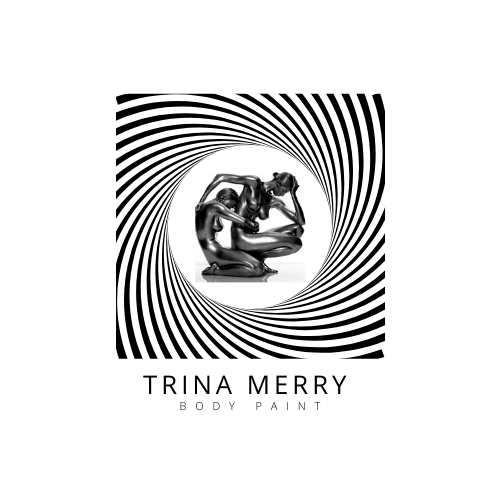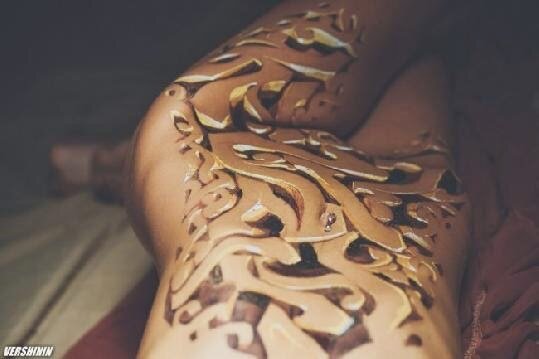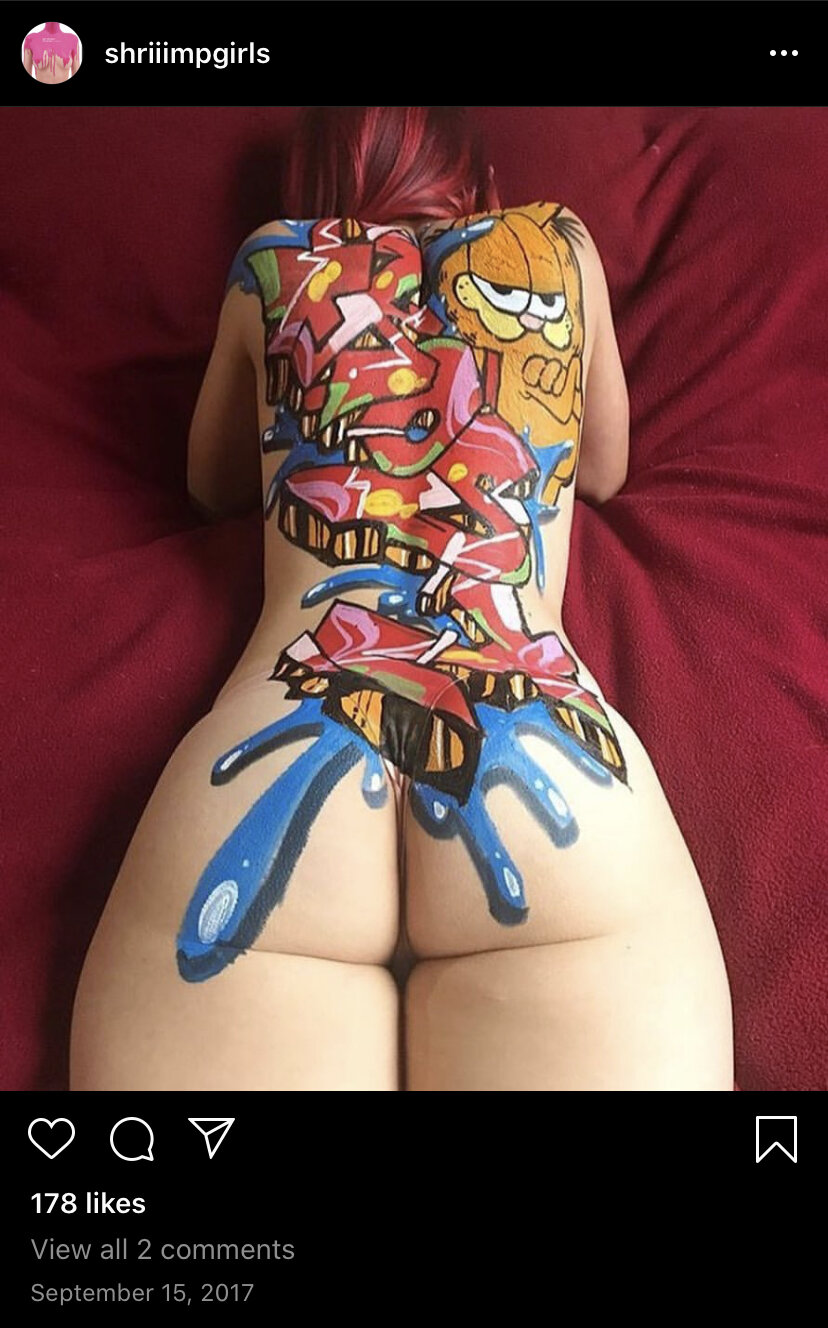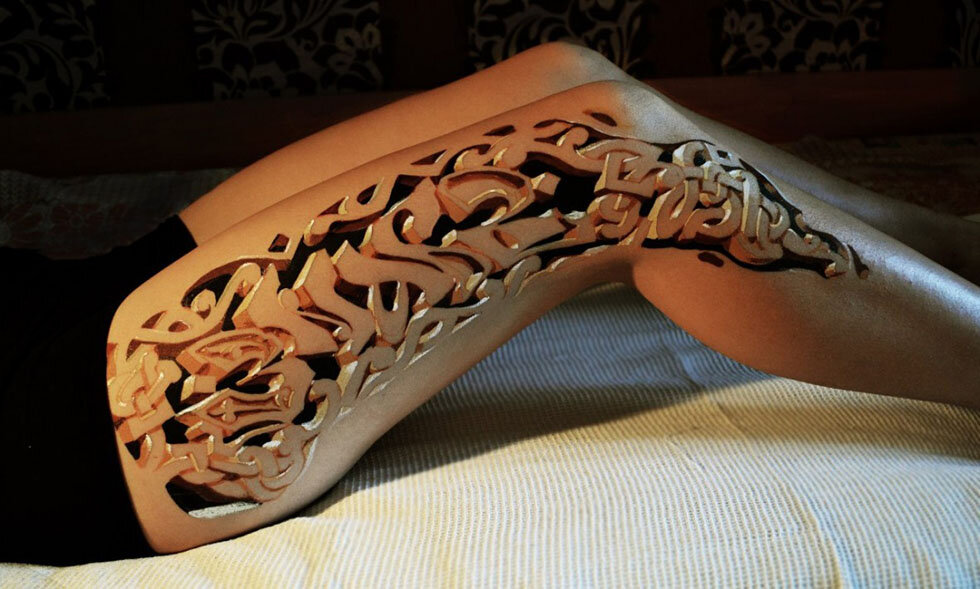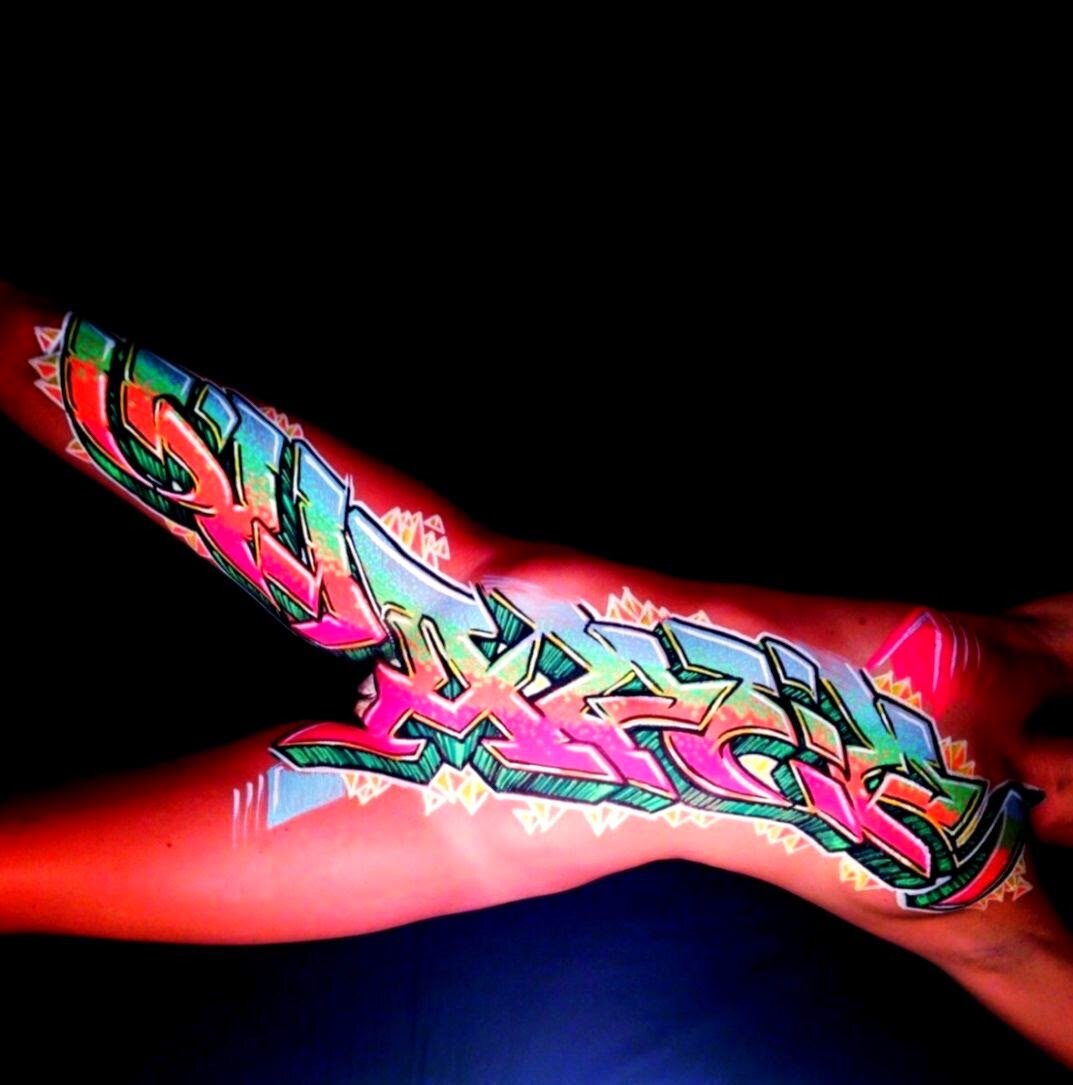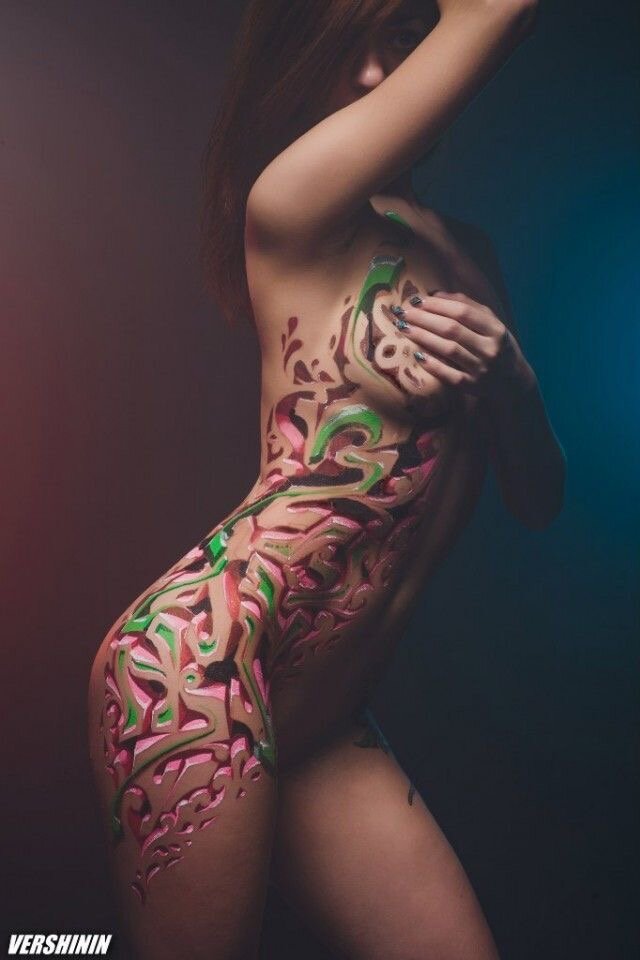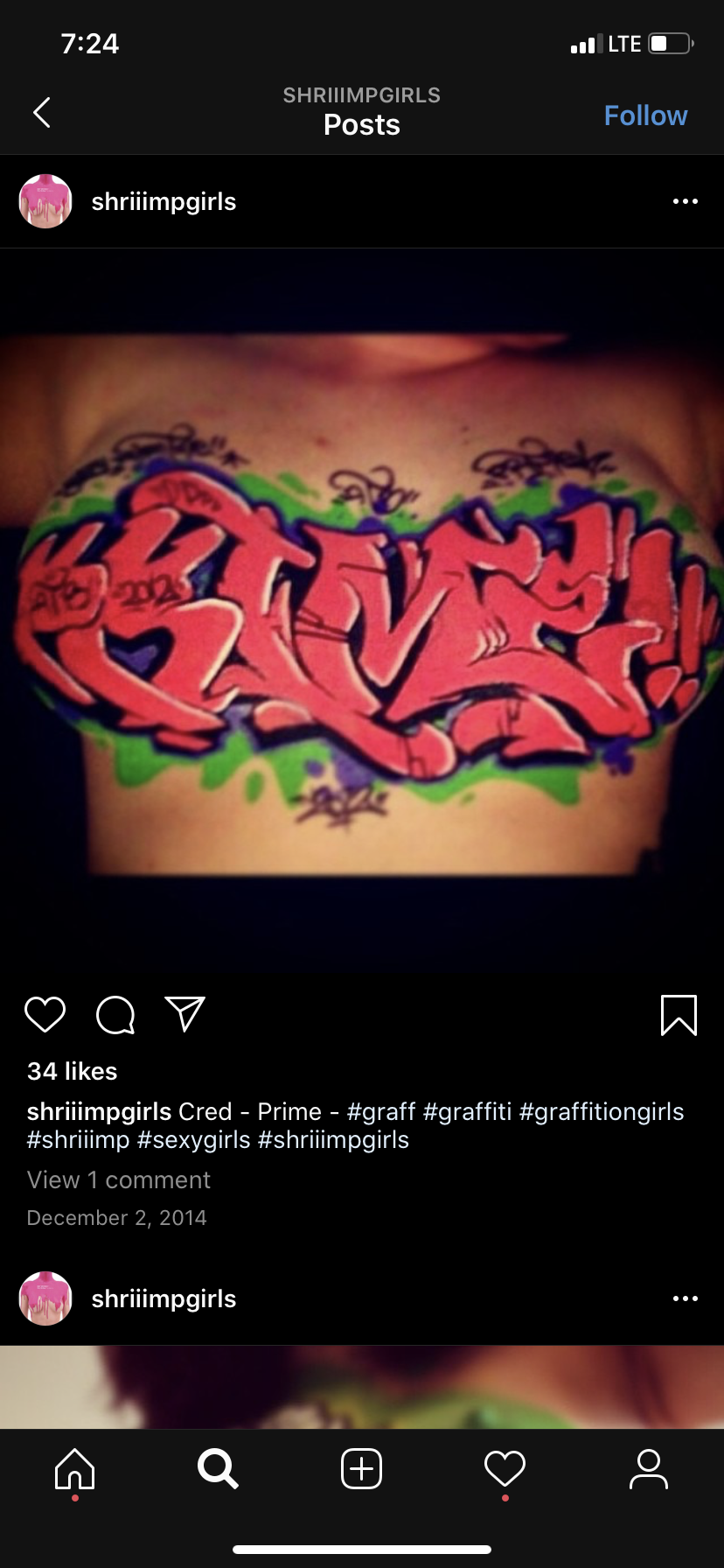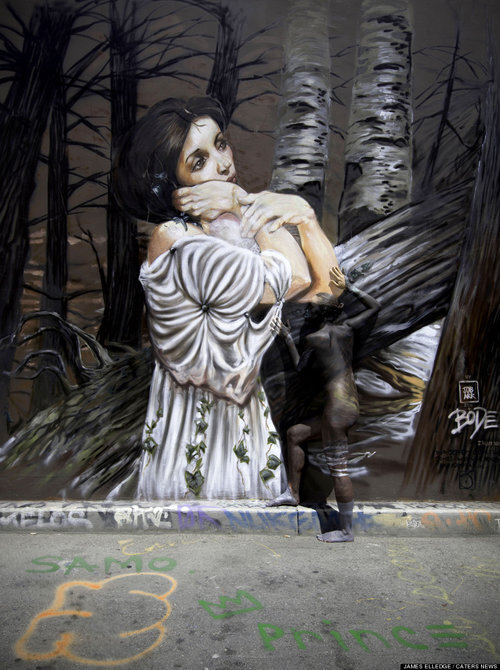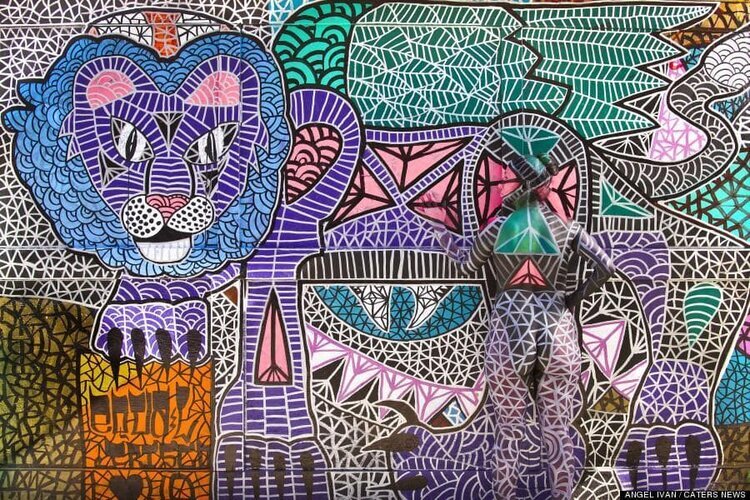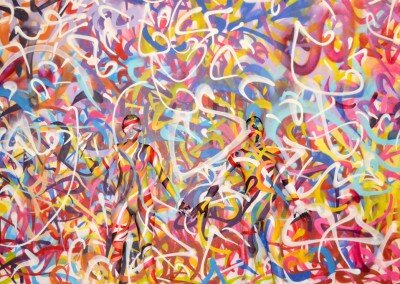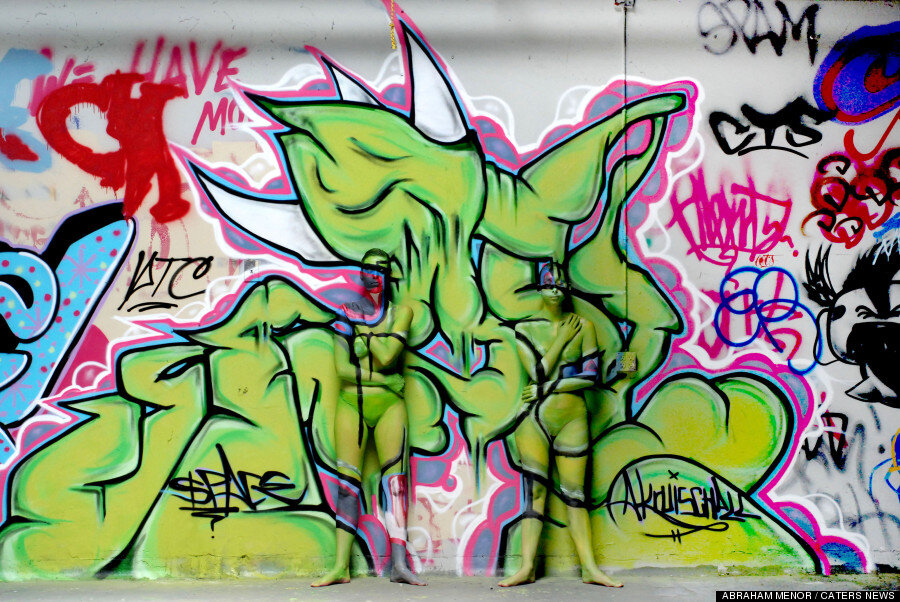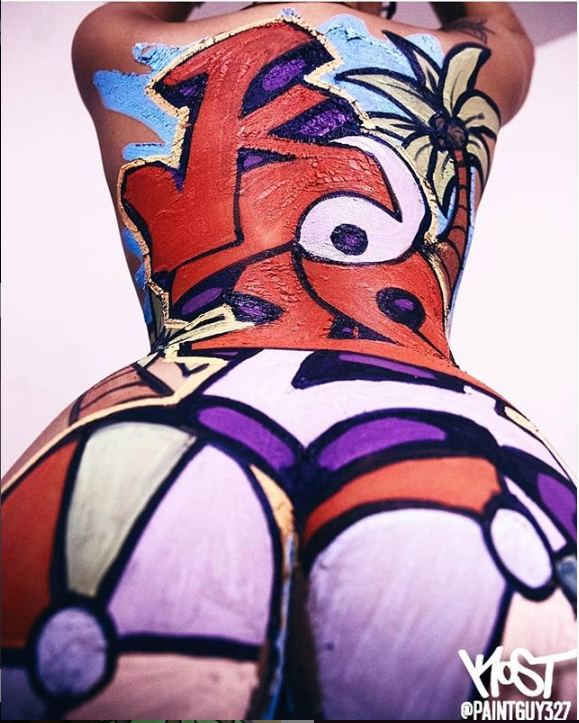No longer restricted to scribbling graffiti art words and murals on brick walls, rooftops and the sides of public transportation vehicles, a ‘00s internet craze saw graffiti artists replace outdoor canvases with women’s bodies.
In 2005, Shriiimp.com was born. Its ‘Graffiti on Girls’ feature invited graffiti artists from around the world to submit photos of their ‘tag’ on women’s backs, legs and chests. One woman had a Bugs Bunny face sprayed across her breasts, for example. For the average viewer, the sharp, colorful graphics of a graffiti body painting, wrapped around the model’s nude frame was immediately striking.
Modern graffiti first shocked the masses in Philadelphia in the early 1960s, before taking the East Coast and the rest of the country by storm through the 70s and became a breeding ground for future legends such as Jean Michel Basquiat.
But Shriiimp.com heralded a whole new era for the artform, taking a sharp turn by melding female sex appeal with graffiti. The site’s founder Vince Prawns based the graffiti body art idea on a trend among graffiti artists for spray painting their girlfriends in their spare time.
Shriiimp Girl via Is This the Future
Shriiimp Girls Become Weirdly Popular
By the end of the noughties, Shriiimp.com had become a sensation within the online graffiti community. Local street art became global online art.
Shriiimp.com reportedly had 60,000 members and received more than 10,000 public submissions of graffiti art letters sprayed across breasts, backs and bums. An episode of hit TV crime drama CSI NY featured a cast member using the phrase ‘I shriiimped that girl’ – a sign of the graffiti body art movement’s advancement into popular culture.
To capitalize on their growing reputation, the brand released a calendar and its own book, Holy Shriiimp, The Bible Vol. 1. The former, a collaboration with art blog ISTHISTHEFUTURE, was named the ‘Graffiti On Girls International Calendar’. It showcased Graffiti Body Art from a group of international artists, including 2BLOK in the US, MR SHIZ in the UK and CHES in Russia. The book, Holy Shriiimp, The Bible Vol. 1., on the other hand, included hundreds of the best photos already uploaded to its website.
Shriiimp’s famed Graffiti On Girls parties in New York City, and ‘live shriiimping’ events built its brand familiarity with socialites, outside of the art community. Live shriiimping was a feature of a party hosted by South African sports retailer Shelflife, in a collaboration with the world-famous Puma brand.
Shriiimp Girls
But what made Graffiti on Girls so popular?
In the early days of modern graffiti in America, many so-called ‘taggers’ were part of street ‘crews’, who marked their territory as a sign to colleagues and rivals. After former New York mayor John Lindsay publicly decried the city for being “heavily defaced by graffiti” and racking up $10 millions a year cleaning bills, graffiti’s perception as a menace solidified. And the debate about whether graffiti is art or vandalism rages on until this very day.
The Shriiimp movement sold two things that sell very well – infamy and sex. Combining the youthful rebellion of graffiti and body art – two art forms often frowned upon by art purists and prohibited in numerous countries – Shriiimp.com provided an accessible platform for these edgy creations to be shared in mass. Using female breasts and bums – areas often objectified in traditional media – as graffiti art canvases only seemed to add to the feeling of notoriety for both artists and models.
Zhang Huan “Family Tree”
The gritty rawness of the graffiti art style is comparable to other striking forms of body art, such as Zhang Huan’s Family Tree art piece. The work features nine sequential photos of Huan’s face and as you follow the images more and more calligraphy is written on his face until it is completely black.
Let’s not forget the time period also. Between 2005 and 2014, internet usage grew and changed phenomenally. During Shriiimp’s baby years, MSN messenger, MySpace and an early Facebook were only just beginning to open our minds to social networking. Shriiimp.com is an early successful internet example of capitalizing on user-generated content from supporters to build niche communities that genuinely touched all corners of the globe. The high activity of supporters leant itself to realer, authentic content built on the desires of fans.
The Backlash
Shriiimp attracted many detractors, and as the 2010s wore on, they got bigger and louder.
Sexism was at the heart of the concerns. Shriiimp.com often argued that its website was supported by many women, and they were an active part of the movement. Some women were said to make their own graffiti art drawings, photograph and submit images themselves.
However, critics argued the simple graffiti artworks were less to do with achieving an artistic goal, but more about ogling nude women. Since its origins in the 1960 and 70s, the graffiti movement has thrived on the idea of tagging public buildings and areas almost as a badge of honor and recognition of ownership. Therefore, to transfer that premise to the female body left many onlookers uncomfortable with the movement.
Shriiimp girls were regularly presented in a sultry fashion, with suggestive poses, suggesting its target audience were more likely to be Playboy magazine readers, than those of the distinguished Women’s Arts Journal, for example.
The nude woman’s body has been used in art and culture for as long as those two mediums have existed. German artist and model Veruschka von Lehndorff was one of the first female icons in modern body painting, but her creations often involved nudity.
However, Vince Prawns’ comments to the Daily Mail didn’t help avoid the criticism: “My two favorites things at one place : Girls & Graffiti" …Graffiti on girls is exclusively for girls, so that means no body art and definitely no guys.”
A second important problem for the movement was that its content was criticized for appearing contrived and one-dimensional. Reviewing Holy Shriiimp, The Bible Vol. 1. Book, a VICE review offered a bruising grilling..
Titled ‘Why Does This Stupid Collection of Boobs and Graffiti Exist?’, writer Matt Shea said: “While I get that many people would find this objectifying and misogynistic, my initial reaction to Holy Shriiimp, The Bible Vol. 1, was that it seems to be a gigantic waste of money and time for everyone involved. And that includes the buyer; the book has an RRP of EUR€15 (US$16), but there's already a huge free archive of these kinds of images on the Shriiimp website.”
He continued: “That's the fundamental pitfall of Holy Shriiimp: naked women are nice to look at, and graffiti can also occasionally be pleasing to the eye, but there's no functional or artistic reason to link the two. You can't really just combine two things and turn it into a book; photos of 17th century Welsh churches overlaid with inspirational quotes from Liverpool's 1996 FA Cup final squad, for example, makes no sense. And nor does this.”
By Wiser Oner
Shriiimp Movement Fries, New Body Artists Evolve
Today, Shriiimp.com no longer exists, suggesting its weaknesses were too much to overcome.
Thankfully, great Graffiti and Body Art creators, who emerged over the last 15 years, have brought more innovation to the niches. Picasso-inspired Italian graffiti artist Hunto wows European crowds with his assortment of colorful, moving, irregular shapes, and has begun applying his talents to body art, examining the relationship between eroticism and human connection. In Australia, body painter Emma Hack makes people disappear behind their favorite wallpaper, and in Russia, graffiti body artist Pasha Znag is inspiring tattoo artists with his specialized body carvings paintings that are spine-tingling to look at.
One of the greatest examples of how the relationship between body art and graffiti has progressed is illustrated by Trina Merry’s fantastic camouflage graffiti body painting series. Partnering with the best graffiti artists around like BODE, Trina Merry transformed San Franciscans into living characters in each mural.
On the city’s most famous street art alleys, Trina Merry used body paint to disguise men and women against the alluring wall murals and often caught locals off guard. Drawing the attention and following of many people, the art project supported the bustling, creative vibe that runs through the veins of California.
Although some models were underdressed, Trina’s graffiti project differed massively from the Shriiimp movement. Rather than a focus on sexuality, the art piece provided energy in amplifying the emotional connection people feel towards San Francisco.
You can check out the camouflage graffiti body painting series here
Airballin
Conclusion
Like Kodak Moments, Myspace pages and many other major hot trends, Shriiimp.com has seemingly had its turn and now it is over. But the once-sensation created and left a hole in the niche that has seen the likes of Trina Merry creatively mesh graffiti and body art styles to a critically acclaimed standard.
